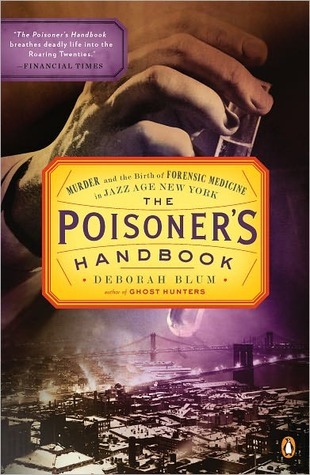More on this book
Community
Kindle Notes & Highlights
by
Deborah Blum
Read between
October 20 - October 29, 2021
Pulitzer Prize winner Deborah Blum is a professor of science journalism at the University of Wisconsin.
AS HE LIKED to boast—and did, as often as possible—John F. “Red Mike” Hylan was a self-made man.
Methyl alcohol is toxic in its own right, as Gettler noted, but formic acid is at least six times more deadly. Further, methyl alcohol metabolizes comparatively slowly, lingering in the body. The conversion to the “more dangerous poisons” can take up to five days, meaning that the wood alcohol drinker can stew in an increasingly lethal cocktail for the better part of a week. Gettler wanted doctors to be aware of, and to watch for, the pattern of a wood alcohol death: a sudden sense of weakness, severe abdominal pain and vomiting, blindness, a slip into unconsciousness, heart failure. He wanted
...more
POISON WAS already in the air that spring of 1918, both figuratively and literally. It tracked through the newspaper headlines in a litany of horror stories–dying children, blinded villagers, dead and disfigured soldiers. The United States had declared war on Germany in April 1917, joining the Great War.
Although traditional weapons killed far more people in the Great War, poison gas gave a new nightmare edge to the fighting. “The chemists’ war,” some people nicknamed it, as Germany experimented with other gases, releasing lethal greenish clouds of chlorine; the French introduced phosgene, which combined chlorine and carbon monoxide; and the Americans developed Lewisite—an ugly combination of chlorine and arsenic.
By the summer of 1918 the United States was also manufacturing mustard gas—“the deadliest instrument of warfare yet devised,” the New York newspapers called
The United States had hesitated at first to use mustard gas, the military said, because it seemed somehow more akin to torture than other weapons.
Prohibition had cranked up the level of violence in the city; gunfights rattling the streets were becoming relatively routine.
In the fall of 1923 he’d begun regular training programs for city detectives. He brought them to the morgue, had them attend autopsies, and sent them to Gettler’s laboratory. There
Four million new cars had been sold nationwide in 1925, and automobile manufacturers predicted with absolute confidence that those numbers could only rise. The National Automobile Show, held at Manhattan’s Grand Central Palace, showcased more than five hundred new models in 1926—bigger cars, more powerful cars, cars riding on the new, cushier balloon tires.
THE BLACK HAND—La Mana Nera in Italian—was an extortion syndicate organized by immigrants in New York and elsewhere (Chicago, San Francisco, and New Orleans) that used a simple and successful formula to acquire money. A letter was sent to a given target (often another Italian-American) threatening murder, arson, or kidnapping, sometimes all three, unless the society was paid off.
Many now drank more than ever, more recklessly, more adventurously. In Washington, D.C., where the Volstead Act—which provided for enforcement of the Eighteenth Amendment—had been militantly approved, the police reported nearly a ten-fold increase in drunk driving arrests since the legislation was enacted.
But the poor could buy only the alcoholic dregs: nickel whiskey from the tenement stills, the Smoke cocktails of the Bowery, straight wood alcohol. More than anyone else, the city’s impoverished residents were paying the real price of Prohibition. The statistics that Gettler delivered to
the government’s determined, ever-expanding use of poisonous additives: aldehol, pyridine, benzene, diethyl phlatate, nicotine, mercury, aniline, phenols.
In early 1930 the Metropolitan Life Insurance Company reported that deaths due to alcoholism were now 600 percent higher (among its 19 million policyholders) than those tallied in 1920, the first year that consumption of alcohol was prohibited.
When the enzymes in the liver break apart methyl alcohol, the result is the two poisons formic acid and formaldehyde. Ethyl alcohol, by contrast, dissolves rather easily into acetic acid, the bitter but basically harmless compound that is the primary constituent in vinegar, and the acid breaks down further into carbon dioxide and water.
From Wisconsin sounded a bitter ode to the drink Ginger Jake. The writer worried that everyone he knew was now messed up by the cocktail.
Jake was based on an old patent medicine, Jamaican Ginger, which was really ginger-flavored ethyl alcohol, between 70 and 80 percent by weight. Following the passage of the Eighteenth Amendment, the government had ordered Jamaican Ginger makers, like Anderson’s Brooklyn company, to reduce the alcohol and double the ginger. This Prohibition-approved recipe turned out to be a money-losing proposition, turning the concoction from a popular tonic (especially among those looking for a cheap drink) to a horribly bitter black syrup.
The FDA, which had been given extremely limited authority when created in 1906 (it could do little more than warn consumers), added the Radithor case to its newly vigorous campaign for expanded legal powers. Both the United States and Europe were discussing new rules restricting all uses of radioactive materials.
Many Americans believed that the alcohol restrictions had contributed to the economy’s collapse, closing breweries, costing jobs, increasing crime, and—as all now admitted—increasing drunkenness.
IN MID-JUNE, Bellevue Hospital and New York University announced the formation of a new department: forensic medicine. It would be the first of its kind in the country, as the dean of the university medical college put it, bringing the United States closer to the level of medical detective work done in Europe.
the illicit alcohol years had changed American culture. Gin, a new cocktail recipe, and a smoky aura had become the necessary atmosphere of any good party or hot speakeasy.
Congress passed and Roosevelt signed the 1938 Food, Drug and Cosmetic Act, which empowered the FDA to demand safety testing and accurate labeling and to hold manufacturers legally responsible for harming their customers.
“If any one person deserves the appellation ‘father of toxicology and forensic chemistry in the United States,’ it is Dr. Gettler.”


